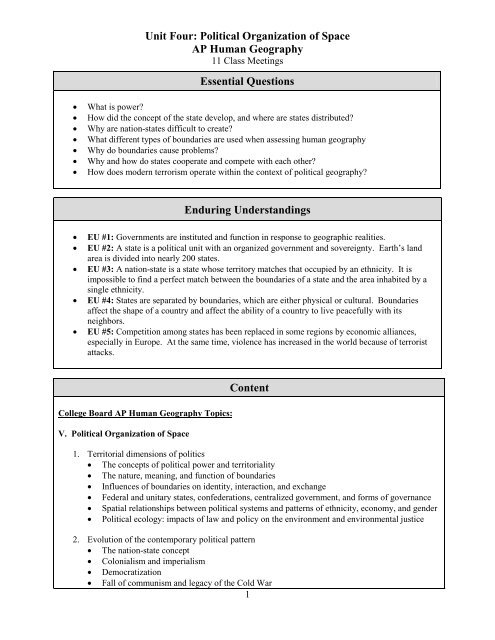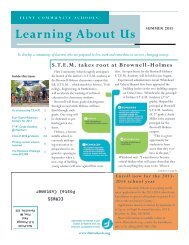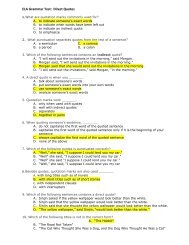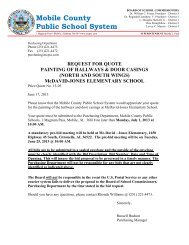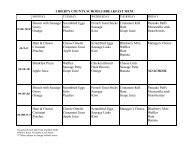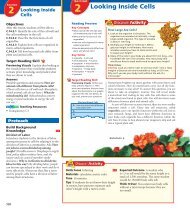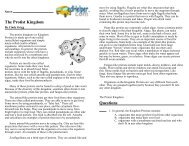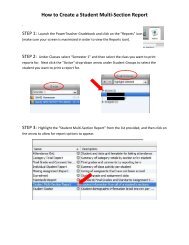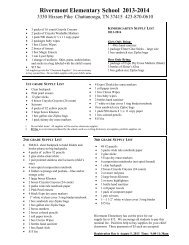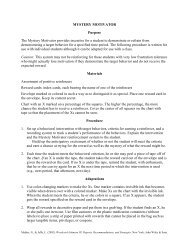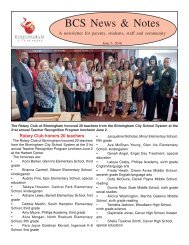Unit Four: Political Organization of Space AP Human Geography ...
Unit Four: Political Organization of Space AP Human Geography ...
Unit Four: Political Organization of Space AP Human Geography ...
Create successful ePaper yourself
Turn your PDF publications into a flip-book with our unique Google optimized e-Paper software.
<strong>Unit</strong> <strong>Four</strong>: <strong>Political</strong> <strong>Organization</strong> <strong>of</strong> <strong>Space</strong><br />
<strong>AP</strong> <strong>Human</strong> <strong>Geography</strong><br />
11 Class Meetings<br />
Essential Questions<br />
<br />
<br />
<br />
<br />
<br />
<br />
<br />
What is power?<br />
How did the concept <strong>of</strong> the state develop, and where are states distributed?<br />
Why are nation-states difficult to create?<br />
What different types <strong>of</strong> boundaries are used when assessing human geography<br />
Why do boundaries cause problems?<br />
Why and how do states cooperate and compete with each other?<br />
How does modern terrorism operate within the context <strong>of</strong> political geography?<br />
Enduring Understandings<br />
<br />
<br />
<br />
<br />
<br />
EU #1: Governments are instituted and function in response to geographic realities.<br />
EU #2: A state is a political unit with an organized government and sovereignty. Earth’s land<br />
area is divided into nearly 200 states.<br />
EU #3: A nation-state is a state whose territory matches that occupied by an ethnicity. It is<br />
impossible to find a perfect match between the boundaries <strong>of</strong> a state and the area inhabited by a<br />
single ethnicity.<br />
EU #4: States are separated by boundaries, which are either physical or cultural. Boundaries<br />
affect the shape <strong>of</strong> a country and affect the ability <strong>of</strong> a country to live peacefully with its<br />
neighbors.<br />
EU #5: Competition among states has been replaced in some regions by economic alliances,<br />
especially in Europe. At the same time, violence has increased in the world because <strong>of</strong> terrorist<br />
attacks.<br />
Content<br />
College Board <strong>AP</strong> <strong>Human</strong> <strong>Geography</strong> Topics:<br />
V. <strong>Political</strong> <strong>Organization</strong> <strong>of</strong> <strong>Space</strong><br />
1. Territorial dimensions <strong>of</strong> politics<br />
The concepts <strong>of</strong> political power and territoriality<br />
The nature, meaning, and function <strong>of</strong> boundaries<br />
Influences <strong>of</strong> boundaries on identity, interaction, and exchange<br />
Federal and unitary states, confederations, centralized government, and forms <strong>of</strong> governance<br />
Spatial relationships between political systems and patterns <strong>of</strong> ethnicity, economy, and gender<br />
<strong>Political</strong> ecology: impacts <strong>of</strong> law and policy on the environment and environmental justice<br />
2. Evolution <strong>of</strong> the contemporary political pattern<br />
The nation-state concept<br />
Colonialism and imperialism<br />
Democratization<br />
Fall <strong>of</strong> communism and legacy <strong>of</strong> the Cold War<br />
1
<strong>Unit</strong> <strong>Four</strong>: <strong>Political</strong> <strong>Organization</strong> <strong>of</strong> <strong>Space</strong><br />
<strong>AP</strong> <strong>Human</strong> <strong>Geography</strong><br />
11 Class Meetings<br />
Patterns <strong>of</strong> local, regional, and metropolitan governance<br />
3. Changes and challenges to political-territorial arrangements<br />
Changing nature <strong>of</strong> sovereignty<br />
Fragmentation, unification, and cooperation<br />
Supranationalism and international alliances<br />
Devolution <strong>of</strong> countries: centripetal and centrifugal forces<br />
Electoral geography: redistricting and gerrymandering<br />
Armed conflicts, war, and terrorism<br />
21 st Century Learning Expectations<br />
#1: Read and write effectively for a variety <strong>of</strong> purposes<br />
#2: Speak effectively with a variety <strong>of</strong> audiences in an accountable manner<br />
#6: Use technology responsibly to create, research, synthesize, and communicate information fluently<br />
#7: Make decisions and solve problems in independent and collaborative settings<br />
#8: Take responsibility for his/her own learning and behavior<br />
#9: Value human, cultural, and natural diversity<br />
#10: Meet their civic responsibilities to society and the natural environment<br />
21 st Century Learning Skills<br />
Common Core - Literacy in History/Social Studies:<br />
Key Ideas and Details<br />
CCSS.ELA-Literacy.RH.11-12.1 Cite specific textual evidence to support analysis <strong>of</strong> primary and<br />
secondary sources, connecting insights gained from specific details to an understanding <strong>of</strong> the text<br />
as a whole.<br />
CCSS.ELA-Literacy.RH.11-12.2 Determine the central ideas or information <strong>of</strong> a primary or<br />
secondary source; provide an accurate summary that makes clear the relationships among the key<br />
details and ideas.<br />
CCSS.ELA-Literacy.RH.11-12.3 Evaluate various explanations for actions or events and<br />
determine which explanation best accords with textual evidence, acknowledging where the text<br />
leaves matters uncertain.<br />
Craft and Structure<br />
CCSS.ELA-Literacy.RH.11-12.4 Determine the meaning <strong>of</strong> words and phrases as they are used in<br />
a text, including analyzing how an author uses and refines the meaning <strong>of</strong> a key term over the<br />
course <strong>of</strong> a text (e.g., how Madison defines faction in Federalist No. 10).<br />
CCSS.ELA-Literacy.RH.11-12.5 Analyze in detail how a complex primary source is structured,<br />
including how key sentences, paragraphs, and larger portions <strong>of</strong> the text contribute to the whole.<br />
CCSS.ELA-Literacy.RH.11-12.6 Evaluate authors’ differing points <strong>of</strong> view on the same historical<br />
event or issue by assessing the authors’ claims, reasoning, and evidence.<br />
Integration <strong>of</strong> Knowledge and Ideas<br />
CCSS.ELA-Literacy.RH.11-12.7 Integrate and evaluate multiple sources <strong>of</strong> information presented<br />
2
<strong>Unit</strong> <strong>Four</strong>: <strong>Political</strong> <strong>Organization</strong> <strong>of</strong> <strong>Space</strong><br />
<strong>AP</strong> <strong>Human</strong> <strong>Geography</strong><br />
11 Class Meetings<br />
in diverse formats and media (e.g., visually, quantitatively, as well as in words) in order to address<br />
a question or solve a problem.<br />
CCSS.ELA-Literacy.RH.11-12.8 Evaluate an author’s premises, claims, and evidence by<br />
corroborating or challenging them with other information.<br />
CCSS.ELA-Literacy.RH.11-12.9 Integrate information from diverse sources, both primary and<br />
secondary, into a coherent understanding <strong>of</strong> an idea or event, noting discrepancies among sources.<br />
Range <strong>of</strong> Reading and Level <strong>of</strong> Text Complexity<br />
CCSS.ELA-Literacy.RH.11-12.10 By the end <strong>of</strong> grade 12, read and comprehend history/social<br />
studies texts in the grades 11–CCR text complexity band independently and pr<strong>of</strong>iciently.<br />
Connecticut State Standards<br />
Standard 1: Content Knowledge<br />
Knowledge <strong>of</strong> concepts, themes, and information from history and social studies is necessary to promote<br />
understanding <strong>of</strong> our nation and our world.<br />
1.1 – Significant events and themes in <strong>Unit</strong>ed States history<br />
1.3 – Significant events and themes in world history/international studies<br />
1.4 – Geographical space and place<br />
1.5 – Interaction <strong>of</strong> humans and the environment<br />
1.6 – Patterns <strong>of</strong> human movement across time and place<br />
1.9 – The rights and responsibilities <strong>of</strong> citizens<br />
1.10 – How limited resources influence economic decisions<br />
1.11 – How different economic systems organize resources<br />
1.12 – The interdependence <strong>of</strong> local, national, and global economies<br />
1.13 – The characteristics <strong>of</strong> and interactions among culture, social systems, and institutions<br />
Standard 2: History/Social Studies Literacy Skills<br />
Competence in literacy, inquiry and research skills is necessary to analyze, evaluate and present history<br />
and social studies information.<br />
2.1 - Access and gather information from a variety <strong>of</strong> primary and secondary sources including<br />
electronic media (maps, charts, graphs, images, artifacts, recordings and text)<br />
2.2 - Interpret information from a variety <strong>of</strong> primary and secondary sources, including electronic<br />
media (maps, charts, graphs, images, artifacts, recordings and text)<br />
2.3 - Create various forms <strong>of</strong> written work (e.g. journal, essay, blog, webpage, brochure) to<br />
demonstrate an understanding <strong>of</strong> history and social studies issues<br />
2.4 - Demonstrate an ability to participate in social studies discourse through informed discussion,<br />
debate, and effective oral presentation<br />
2.5 - Create and present relevant social studies materials using both print and electronic media (e.g.<br />
maps, charts, models, displays)<br />
Standard 3: Civic Engagement<br />
Civic competence in analyzing historical issues and current problems requires the synthesis <strong>of</strong> information,<br />
skills and empathic awareness.<br />
<br />
<br />
3.1 - Use evidence to identify, analyze and evaluate interpretations<br />
3.2 - Analyze and evaluate human action in historical and/or contemporary contexts from<br />
alternative points <strong>of</strong> view<br />
3
<strong>Unit</strong> <strong>Four</strong>: <strong>Political</strong> <strong>Organization</strong> <strong>of</strong> <strong>Space</strong><br />
<strong>AP</strong> <strong>Human</strong> <strong>Geography</strong><br />
11 Class Meetings<br />
3.3 – Apply appropriate historical, geographic, political, economic, and cultural concepts and<br />
methods in proposing and evaluating solutions to contemporary problems<br />
Objectives<br />
Students will be able to…<br />
<br />
<br />
<br />
<br />
<br />
<br />
<br />
<br />
<br />
<br />
<br />
<br />
<br />
<br />
Explain the concept <strong>of</strong> state by identifying necessary qualifications and characteristics and listing<br />
examples <strong>of</strong> states in various regions<br />
Explain the difference between a nation-state and a multinational state<br />
List advantages and disadvantages <strong>of</strong> different types <strong>of</strong> boundaries and provide real-world<br />
examples <strong>of</strong>: natural/physical boundaries, cultural boundaries, and geometric boundaries<br />
Identify different shapes <strong>of</strong> states and provide real-world examples<br />
Describe and apply the following concepts to the political map: federal and unitary states,<br />
confederations, centralized government, and forms <strong>of</strong> governance<br />
Define the concepts <strong>of</strong> imperialism and colonialism and illustrate some <strong>of</strong> their consequences on<br />
the contemporary political map<br />
Trace the evolution <strong>of</strong> the current political pattern<br />
Define the concept <strong>of</strong> supranationalism and provide real-world examples <strong>of</strong> internationalism<br />
alliances<br />
Define the concepts <strong>of</strong> redistricting and gerrymandering as they relate to political geography<br />
Explain the difference between centripetal and centrifugal forces as they relate to political<br />
geography<br />
Define irredentism and devolution and illustrate each with examples<br />
Explain the concept <strong>of</strong> terrorism and describe ways that states have sponsored terrorism<br />
Research a current political issue and apply the case study to prove or disprove a geographic thesis<br />
Produce written work that reflects an understanding <strong>of</strong> geographic models and spatial concepts<br />
Assessments<br />
Reading Quiz: <strong>Political</strong> <strong>Geography</strong> (Chapter 8)<br />
Place <strong>Geography</strong> Quiz<br />
Lab: “Breaking Up Is Hard to Do: Nations, States, and Nation-States”<br />
o Rubric 6: Technology – Student uses technology responsibly to create, research, synthesize,<br />
and communicate information fluently.<br />
Roundtable: <strong>Political</strong> Issues<br />
o Rubric 2: Accountable Talk – Student speaks effectively with a variety <strong>of</strong> audiences in an<br />
accountable manner<br />
Essay: Guns, Germs, and Steel Application<br />
o Rubric 1: Communication – Student reads and writes effectively for a variety <strong>of</strong> purposes<br />
<strong>Unit</strong> 4 Vocabulary List<br />
o Rubric 8: Student Ownership – Student takes responsibility for own learning and behavior<br />
Midterm Exam (Multiple Choice and Essay)<br />
4
<strong>Unit</strong> <strong>Four</strong>: <strong>Political</strong> <strong>Organization</strong> <strong>of</strong> <strong>Space</strong><br />
<strong>AP</strong> <strong>Human</strong> <strong>Geography</strong><br />
11 Class Meetings<br />
Resources<br />
<br />
<br />
<br />
<br />
<br />
<br />
<br />
<br />
Textbook (The Cultural Landscape: An Introduction to <strong>Human</strong> <strong>Geography</strong> <strong>AP</strong> Edition)<br />
Case Studies / Lab Manual (<strong>Human</strong> <strong>Geography</strong> in Action)<br />
Guest Speaker: Mr. Steve Woods, Special Agent, U.S. Department <strong>of</strong> the Treasury<br />
Supplementary Readings including Guns, Germs, and Steel<br />
MSMHS School-wide Rubrics<br />
Video Clips (How the States Got Their Shapes, 200 Countries, 200 Years, 4 Minutes, Inside North<br />
Korea)<br />
Laptops<br />
Internet<br />
5


